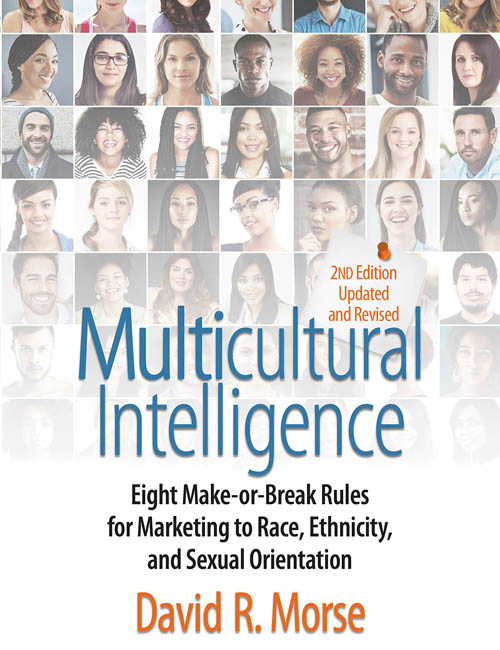Reviewed by Janet Standen, Co-Founder, Scoot Insights
San Francisco, CA, janet@scootinsights.com
David R. Morse’s Multicultural Intelligence: Eight Make-or-Break Rules for Marketing to Race, Ethnicity, and Sexual Orientation provides a foundational and interesting review of the history, the current state, and his projections on multiculturalism’s impact and role in the US. Read this book and you will be significantly better informed on multiculturism, benefitting both your personal life and your professional life.
This 2017 second edition incorporates major revisions and additions to the 2009 first edition. Morse has added significant amounts of new data from the US Census, Pew and from many other sources, to underpin his perspectives on the ever-changing face of what he identifies as four discrete cultures: Hispanic-, African-, Asian-, and LGBT- Americans. He asserts that they each “have distinct identities that separate them from the mainstream,” and have “unique needs when it comes to the types of brands or products they buy and that they need to be communicated with differently in order to be persuaded to become customers.” When Hispanics, Asian Americans and African Americans represent $3.5 trillion in purchasing power, it is imperative to understand them, respect them, and know how to reach them.
Morse has also clearly done his homework on the evolution of each group, their treatment in the media, and the success of various companies’ efforts to connect with them. Morse helps make the data come to life by integrating individual stories he garnered from the hundreds of interviews he conducted with multicultural Americans and experts.
Multiculturism is a complex topic. For example, the term Asian American over-simplifies the 22 or more races and ethnicities the term represents, which are as diverse and different from each other as Japan is from China or Singapore is from India. The same goes for Hispanic Americans—who in the US are majority Mexican (two-thirds), and embrace ethnicities as diverse as Puerto Ricans (who are native born US citizens), Colombians and Peruvians, to name but a few.
The book is divided into two sections. In Part I, Meet the New Americans, Morse does a successful job in highlighting the similarities, but mainly the differences, between these four discrete cultures—although of course LGBT Americans also reside within the other three groups. He raises a fundamental question, “Is America the ‘melting pot’ so often referred to, or is it more of a ‘salad bowl’? In this book, he demonstrates that it is currently more of a salad bowl—sometimes, and in some places, the ingredients appear to integrate together well into a harmonious and familiar experience that could be considered mainstream, and at other times the ingredients appear to be mixed together but have such different flavors that they remain discrete in character and fail to assimilate.
Taking the culinary analogy one step further, he paints a picture of the US today as a multicultural recipe book. Each chapter in Part 1 has its own distinct cultural character, with recipes born of deep-rooted differences in heritage that are passed down from previous generations, but slowly adapted by each new generation to better fit their own tastes, and which slowly evolve as the world in which they are immersed exposes them to new influences and experiences.
Morse reminds us that “today’s young Americans have known nothing but a truly multicultural America.” This is borne out by their regular diet of foods from multiple cultures and often a fusion of different cuisines. “Millennials are the most diverse adult generation in US history. In 2016 they were about 56% white, compared with 72% of Baby Boomers, and the white percentage drops to 50% when looking at those ages 12 and under, meaning that well before 2020 white children will become a minority.”
If ethnic distinctions go away, then multicultural marketing will become extinct and the concept of Total Market Approach (TMA), where diverse segment considerations must be integrated within one overarching mainstream marketing strategy, will likely continue to be embraced by an increasing number of top companies that will join the likes of Toyota, Clorox, and Wells Fargo. In the meantime, we as researchers will need to determine how research practices can best support both multicultural marketing and TMA.
In Part II, Morse outlines the Eight Make-or-Break Rules for Marketing to Race, Ethnicity, and Sexual Orientation, which are referenced in the title. Morse provides eight distinct, insightful, and constructive suggestions to understanding and operating in a world of multiculturism.
Multicultural Intelligence provides a valuable guide to anyone in a role informing or designing multicultural marketing and communications, and it is an invaluable guide to anyone who can be held responsible for it.


Be the first to comment